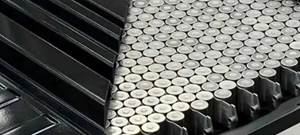First DLR rotor blade headed for load testing
DLR energy researchers have manufactured the first rotor blade (Smartblade) that adapts to wind conditions using bending torsion coupling.
Researchers at the German Aerospace Center (Deutsches Zentrum für Luft- und Raumfahrt; DLR) have completed the first rotor blade as part of the SmartBlades2 project. The rotor blade with a length of 20 metres can adapt to varying wind conditions using bending torsion coupling. At the beginning of 2018, the rotor blade will be subjected to numerous load tests at the Fraunhofer Institute for Wind Energy and Energy System Technology (IWES) in Bremerhaven. In the research project SmartBlades2, industry and research facilities are developing innovative technologies for larger and more powerful wind turbines. The project is supported by the German Federal Ministry for Economic Affairs and Energy (BMWi).
During the rotation of a large wind turbine with rotor blades 80 metres and longer, each rotor blade is intermittently positioned close to the ground and a short time later at a height of around 200 metres. Due to the uneven wind distribution between ground level and the top section of the wind turbine, rotor blades are subjected to strong fluctuations in wind load. This results in high stresses for the rotor blade material, particularly when operating at the nominal capacity of the turbine. Additionally, wind turbine operators need to restrict the wind turbines in strong winds and cannot optimally exploit the energy of the wind flow. Rotor blades with bending torsion coupling are able to independently adapt their geometry to the wind conditions. At higher wind speeds the rotor blade twists, thus exposing less contact surface to the wind, which enables the load on the installation to be reduced.
At the Center for Lightweight-Production-Technology (ZLP), located at the DLR site in Stade, scientists from the DLR Institute of Composite Structures and Adaptive Systems have produced a 20-metre-long rotor blade with structural bending torsion coupling. In doing so, the materials of the blade (glass-fiber reinforced plastic, wood and plastic foam) are placed in such a way that under wind load the blade not only bends backwards, but above all twists. "Because of the innovative structure the rotor blades are more flexible, at the same time allowing them to be lighter and less massive. Particularly for very large wind turbines, less weight is a great benefit and additionally makes transportation and assembly easier," says Zhuzhell Montano Rejas, project manager of SmartBlades2 at the DLR Institute of Composite Structures and Adaptive Systems.
From December on, the load tests will be conducted on a rotor blade test rig at the Fraunhofer IWES in Bremerhaven. Here, the load-bearing capacity of the rotor blade will be tested under extreme loads and under normal operating conditions in order to determine the blade properties and their deformation behavior. The scientists pay special attention to whether bending and torsion of the rotor blade optimally complement one another. The scientists have integrated measuring sensors inside the rotor blade for accurate data recording during the load tests. This allows them to observe structural and material deformations. Once a sufficient load-bearing capacity has been confirmed, within the coming year the scientists will produce a complete three-blade rotor with the same dimensions, which they will subject to open air wind turbine testing under realistic load and weather conditions at the US National Renewable Energy Laboratory (NREL).
Further technologies investigated in the project are adaptive trailing edge flaps and leading edge slats. Both concepts come from aviation and are comparable to the flaps on aircraft wings. In addition, researchers are working on the further development of selected methods and technologies such as the aerodynamic behaviour of rotor blades and control of the entire system.
Related Content
Composites end markets: Batteries and fuel cells (2024)
As the number of battery and fuel cell electric vehicles (EVs) grows, so do the opportunities for composites in battery enclosures and components for fuel cells.
Read MoreComposites end markets: Automotive (2024)
Recent trends in automotive composites include new materials and developments for battery electric vehicles, hydrogen fuel cell technologies, and recycled and bio-based materials.
Read MoreMingYang reveals 18-MW offshore wind turbine model with 140-meter-long blades
The Chinese wind turbine manufacturer surpasses its 16-MW platform, optimizes wind farm construction costs for 1-GW wind farms.
Read MoreCollins Aerospace to lead COCOLIH2T project
Project for thermoplastic composite liquid hydrogen tanks aims for two demonstrators and TRL 4 by 2025.
Read MoreRead Next
Developing bonded composite repair for ships, offshore units
Bureau Veritas and industry partners issue guidelines and pave the way for certification via StrengthBond Offshore project.
Read MoreVIDEO: High-volume processing for fiberglass components
Cannon Ergos, a company specializing in high-ton presses and equipment for composites fabrication and plastics processing, displayed automotive and industrial components at CAMX 2024.
Read MorePlant tour: Daher Shap’in TechCenter and composites production plant, Saint-Aignan-de-Grandlieu, France
Co-located R&D and production advance OOA thermosets, thermoplastics, welding, recycling and digital technologies for faster processing and certification of lighter, more sustainable composites.
Read More











.jpg;maxWidth=300;quality=90)












